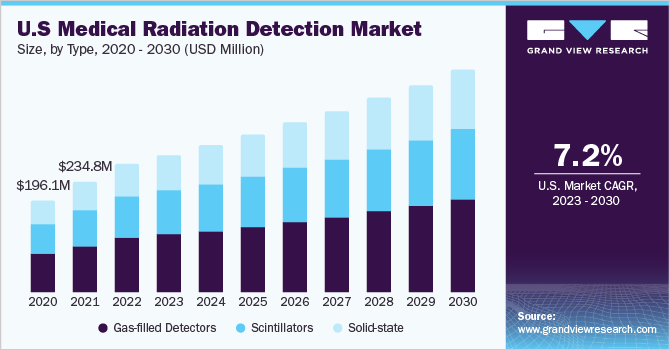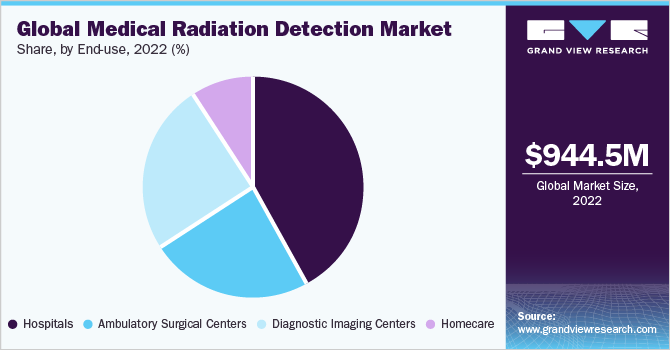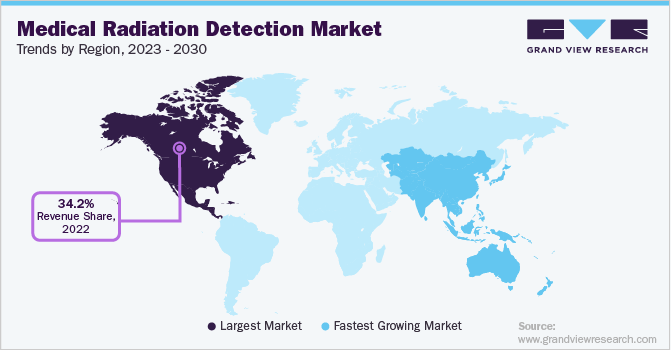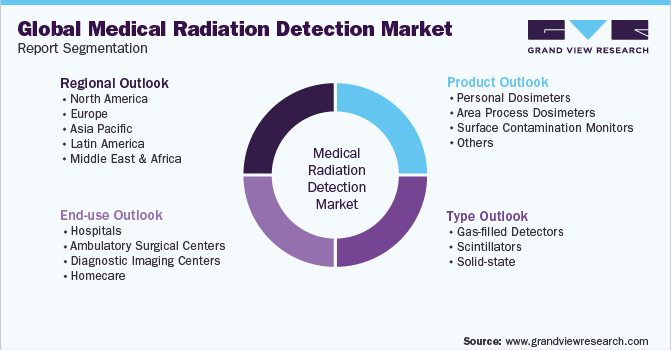- Home
- »
- Medical Devices
- »
-
Medical Radiation Detection Market Size & Share ReportGVR Report cover
![Medical Radiation Detection Market Size, Share & Trends Report]()
Medical Radiation Detection Market Size, Share & Trends Analysis Report By Type (Gas-filled Detector, Scintillators), By Product (Personal Dosimeters, Area Process Dosimeters), By End-use, By Region, And Segment Forecasts, 2023 - 2030
- Report ID: GVR-4-68040-057-8
- Number of Report Pages: 150
- Format: PDF, Horizon Databook
- Historical Range: 2018 - 2021
- Forecast Period: 2023 - 2030
- Industry: Healthcare
Report Overview
The global medical radiation detection market size was valued at USD 944.52 million in 2022 and is expected to grow at a compound annual growth rate (CAGR) of 7.53% from 2023 to 2030. The use of medical imaging technologies such as X-rays, and CT scans are increasing, which, in turn, increases greater demand for radiation detection to ensure that patients and healthcare workers are not exposed to excessive radiation doses. According to the World Health Organization (WHO), cancer is one of the leading causes of death worldwide. In 2020, there were an estimated 19.3 million new cases of cancer and 10 million cancer-related deaths worldwide. This is further influencing the demand for radiotherapy treatment and diagnostic devices the devices emits radiation which in turn propels the demand for detection devices.

The devices used for the medical radiation detection, monitoring and safety lowers the effects of hazardous radiations. The medical radiation detection & monitoring is permitted to monitor the workplace conditions and individual exposures to assure safe radiological conditions in the workplace such as imaging centers and hospitals.
Governments around the world have recognized the potential risks associated with medical radiation exposure and have implemented policies and guidelines to regulate its use. For example, in the United States, the Food and Drug Administration (FDA) has issued guidelines to healthcare providers to help minimize radiation exposure from medical imaging. The FDA recommends using the lowest possible radiation dose necessary to obtain a diagnostic quality image and avoiding unnecessary imaging exams. The Centers for Medicare and Medicaid Services (CMS) have also implemented a program to encourage the appropriate use of advanced diagnostic imaging services.
The COVID-19 pandemic has significantly impacted the healthcare industry, including the medical radiation detection, monitoring and safety market. The pandemic has led to an increased demand for medical imaging procedures, such as chest X-rays and CT scans, to diagnose and monitor COVID-19 patients.
The increased demand for medical imaging has also led to an increased need for medical radiation detection devices. Healthcare workers are at risk of radiation exposure during imaging procedures, and the use of detection devices can help monitor and limit their radiation exposure.
The pandemic has also led to changes in the way medical imaging procedures are performed. To reduce the risk of COVID-19 transmission, many healthcare facilities have implemented new protocols, such as using portable X-ray machines and limiting the number of healthcare workers in the room during imaging procedures. These changes have increased the need for portable and handheld medical radiation detection devices that can be used in a variety of settings.
Type Insights
On the basis of type, the market is further segmented into gas-filled detectors, scintillators,andsolid-state. Gas-filled detectors accounted for the highest revenue share of over 42.03% in 2022 owning popularity due to several advantages they offer over other types of radiation detectors. For instance, gas-filled detectors are highly sensitive to ionizing radiation and can detect very low levels of radiation, making them ideal for use in environments where radiation levels need to be monitored carefully. Additionally, gas-filled detectors are able to detect a wide range of radiation types, including alpha particles, beta particles, gamma rays, and X-rays, which makes them versatile and suitable for use in a variety of applications. Solid-state detectors is expected to grow at the fastest CAGR over the forecast period. Solid-state detectors are highly efficient at detecting ionizing radiation, they can convert a large proportion of incident radiation into an electrical signal. This allows them to detect very low levels of radiation with high accuracy. For example, according to the U.S. Nuclear Regulatory Commission, solid-state detectors are more efficient than gas-filled detectors for detecting low-energy gamma rays.
Product Insights
On the basis of product, the market is further segmented into personal dosimeters, area process dosimeters, surface contamination monitors, and others. Personal dosimeters accounted for the highest revenue share of around 39.9% in 2022 owning to its properties such as being lightweight, and easy to access. Personal dosimeters are used to monitor the amount of radiation exposure that workers receive in environments where radiation exposure is a risk. This is particularly important in industries such as nuclear power, medical imaging, and radiography, where workers are exposed to ionizing radiation. It ensures that workers are not exposed to dangerous levels of radiation, protecting their health and safety. Area process dosimeters provide real-time monitoring of radiation levels, allowing operators to make adjustments to the process as needed. This helps to prevent overexposure to radiation and ensures that the process is functioning optimally.
End-use Insights
On the basis of end-use the market is segmented into hospitals, ambulatory surgical centers diagnostic imaging centers, and home care. The hospitals segment accounted for the highest revenue share of around 41.97% in 2022. This is attributed to the increasing geriatric population and an increase in chronic diseases, there is a growing demand for medical imaging procedures, such as X-rays, CT scans, and PET scans. As per the estimates of the United Nation in 2019 approximately 703 million people globally were more than 65 years aforementioned factor is driving the market. Medical radiation detectors are essential in these procedures to ensure that patients receive the correct amount of radiation and to prevent overexposure.

The diagnostic imaging centers are expected to grow at the fastest CAGR over the forecast period owing to themedical radiation advancements in technology, manufacturers are making detectors more accurate, reliable, and user-friendly. For instance, some detectors now use solid-state detectors, which offer higher efficiency and sensitivity than gas-filled detectors.
Regional Insights
North America dominated the global market and accounted for a revenue share of 34.20% in 2022 this is attributed to growing concern about the potential risks associated with exposure to ionizing radiation in medical procedures. As a result, medical facilities and regulatory bodies are placing more emphasis on radiation safety. This has led to an increase in demand for medical radiation detectors that can accurately measure radiation levels and help ensure patient safety.
Additionally, the governments in North America have implemented strict regulations on the use of radiation in medical procedures. This has led to an increase in demand for medical radiation detectors that can ensure compliance with these regulations.

The Asia Pacific region is expected to grow at the fastest CAGR of 7.98% owing to an increase in chronic diseases such as cancer. Many cancer treatments, such as radiation therapy, use ionizing radiation. As the incidence of cancer continues to rise, the demand for medical radiation detectors is also increasing to help ensure that patients receive safe and effective treatment. As per the estimates of NIH in 2020 Asian region witnessed 49.3 of global cancer incidences.
Key Companies & Market Share Insights
The global medical radiation detection market is highly fragmented with several players competing for market share, major market participants are implementing a variety of business tactics, such as creating strategic alliances, collaborations and mergers. Some of the prominent players operating in the global medical radiation detection market:
-
Thermo Fisher Scientific, Inc.
-
UAB Polimaster Europe
-
PTW Freiburg GmbH
-
ATOMTEX
-
Sanlar imex services private limited
-
LANDAUER
-
Mirion Technologies, Inc
-
MP BIOMEDICALS.
-
SIERRA RADIATION DOSIMETRY SERVICE, INC.
-
IBA Dosimetry GmbH
Medical Radiation Detection Market Report Scope
Report Attribute
Details
Market size value in 2023
USD 1,012.35 million
Revenue forecast in 2030
USD 1,683.35 million
Growth rate
CAGR of 7.53% from 2023 to 2030
Base year for estimation
2022
Historical data
2018 - 2021
Forecast period
2023 - 2030
Quantitative units
Revenue in USD million & CAGR from 2023 to 2030
Report coverage
Revenue forecast, company share, competitive landscape, growth factors & trends
Segments covered
Type, product, end-use, region
Regional scope
North America; Europe; Asia Pacific; Latin America; Middle East & Africa
Country scope
U.S.; Canada; U.K.; Germany; France; Italy; Spain; Denmark; Sweden; Norway; China; Japan; India; South Korea; Australia; Thailand; Brazil; Mexico; Argentina; South Africa; Saudi Arabia; UAE; Kuwait
Key companies profiled
Thermo Fisher Scientific, Inc.; UAB Polimaster Europe; PTW Freiburg GmbH; ATOMTEX; Sanlar imex services private limited; LANDAUER;Mirion Technologies, Inc; MP BIOMEDICALS.; SIERRA RADIATION DOSIMETRY SERVICE, INC.; IBA Dosimetry GmbH
15% free customization scope (equivalent to 5 analysts working days)
If you need specific market information, which is not currently within the scope of the report, we will provide it to you as a part of customization
Pricing and purchase option
Avail customized purchase options to meet your exact research needs. Explore purchase options
Global Medical Radiation Detection Market Report Segmentation
This report forecasts revenue growth at the global, regional & country levels and provides an analysis of the latest trends and opportunities in each of the sub-segments from 2018 to 2030. For this study, Grand View Research has segmented the global medical radiation detection market report based on type, product, end-use, and region:

-
Type Outlook (Revenue, USD Million, 2018 - 2030)
-
Gas-filled Detectors
-
Scintillators
-
Solid-state
-
-
Product Outlook (Revenue, USD Million, 2018 - 2030)
-
Personal Dosimeters
-
Area Process Dosimeters
-
Surface Contamination Monitors
-
Others
-
-
End-use Outlook (Revenue, USD Million, 2018 - 2030)
-
Hospitals
-
Ambulatory Surgical Centers
-
Diagnostic Imaging Centers
-
Homecare
-
-
Regional Outlook (Revenue, USD Million, 2018 - 2030)
-
North America
-
U.S.
-
Canada
-
-
Europe
-
U.K.
-
Germany
-
France
-
Italy
-
Spain
-
Denmark
-
Sweden
-
Norway
-
-
Asia Pacific
-
Japan
-
China
-
India
-
Thailand
-
Australia
-
South Korea
-
-
Latin America
-
Brazil
-
Mexico
-
Argentina
-
-
Middle East & Africa
-
South Africa
-
Saudi Arabia
-
UAE
-
Kuwait
-
-
Frequently Asked Questions About This Report
b. North America dominated the medical radiation detection market with a share of 34.20% in 2022. This is attributed to growing concern about the potential risks associated with exposure to ionizing radiation in medical procedures. As a result, medical facilities and regulatory bodies are placing more emphasis on radiation safety.
b. Some key players operating in the medical radiation detection market include Thermo Fisher Scientific, Inc., UAB Polimaster Europe, PTW Freiburg GmbH, ATOMTEX, Sanlar imex services private limited, LANDAUER, Mirion Technologies, Inc, MP BIOMEDICALS. , SIERRA RADIATION DOSIMETRY SERVICE, INC., IBA Dosimetry GmbH
b. Factors including increased demand for medical imaging have also led to an increased need for medical radiation detection devices. Healthcare workers are at risk of radiation exposure during imaging procedures, and the use of detection devices can help monitor and limit their exposure to radiation.
b. The global medical radiation detection market size was estimated at USD 944.52 million in 2022 and is expected to reach USD 1,012.35 million in 2023.
b. The global medical radiation detection market is expected to grow at a compound annual growth rate of 7.53% from 2023 to 2030 to reach USD 1,683.35 million by 2030.
Share this report with your colleague or friend.
![gvr icn]()
NEED A CUSTOM REPORT?
We can customize every report - free of charge - including purchasing stand-alone sections or country-level reports, as well as offer affordable discounts for start-ups & universities. Contact us now
![Certified Icon]()
We are GDPR and CCPA compliant! Your transaction & personal information is safe and secure. For more details, please read our privacy policy.
We are committed towards customer satisfaction, and quality service.
"The quality of research they have done for us has been excellent."





